GeoGebra interactive books – creative material developing and sharing
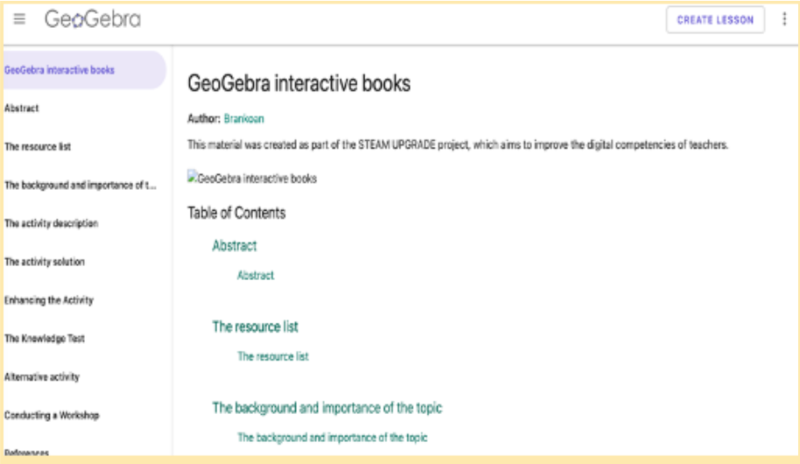
Abstract: The textbooks and other digital teaching and learning tools that are used in schools in the majority of European countries are developed on the principles of Universal design. The basic principles of universal design are Equitable Use, Flexibility in Use, Simple and Intuitive Use, Perceptible Information, Tolerance for Error, Low Physical Effort, and Size and Space for Approach and Use. This style of design encourages the participation of all people in all aspects of life and the potential of equitable access to education for all children, pupils, students, and adults, regardless of the diversity they may be wearing. Taking into consideration that the diversity of students in the classroom is very often huge, in terms of students' abilities, interests, and similar characteristics, there is often a need for teachers to develop teaching in learning materials that are in line with students' characteristics which they teach. Very often teachers face obstacles in sharing different types of developed materials such as texts, video, audio, or animated educational materials. This example will provide teachers with information about developing GeoGebra interactive books and integrating different teaching in learning materials (video, animations, text and so on) in the book.
Keywords: GeoGebra, interactive text book, digital learning materials, development of educational materials.
The resource list:GeoGebra account, GeoGebra application, developed digital educational materials.
The background and importance of the topic
Contemporary education is aiming to be based on constructivist learning and teaching principles. This means that teaching and learning should be as much as possible adapted to the individual learner's students' characteristics, previous knowledge, and experience (Anđić et al. 2021). Taking into consideration that conventional educational materials such as textbooks, animations, and videos are intended for a huge number of students, that means they hardly can be adapted to individual student's characteristics, they are rather adapted to characteristics of student groups. Teachers are in a position to develop teaching and learning material adapted to their students, teaching goals, and environment. The development of digital educational technologies is placed teachers in the position of developers with different teaching and learning materials which could be in the form of text, video, animation, AR, VR, or digital 3D models. Educational materials created in a fast-changing digital environment bring to the teacher obstacles of it sharing with students, colleagues, or target groups (Lavicza et al. 2022; Alvino et al. 2009). GeoGebra as global learning platform with over 100 million users worldwide is offering to teacher possibility to developed, share and use interactive digital books, in which they can integrate other educational materials (text, video, audio, animation, AR, VR, digital 3D models…).
The activity description
In an aim to be able to develop GeoGebra interactive books, teachers should have their or institutional GeoGebra profile. To create GeoGebra account teachers should visit the GeoGebra webpage, detailed explanation is available in this video.
After the successful creation of the GeoGebra account, all requirements for the development of GeoGebra interactive books are fulfilled. In the next step, teachers should visit their profile on GeoGebra, by clicking on their profile icon, figure1.
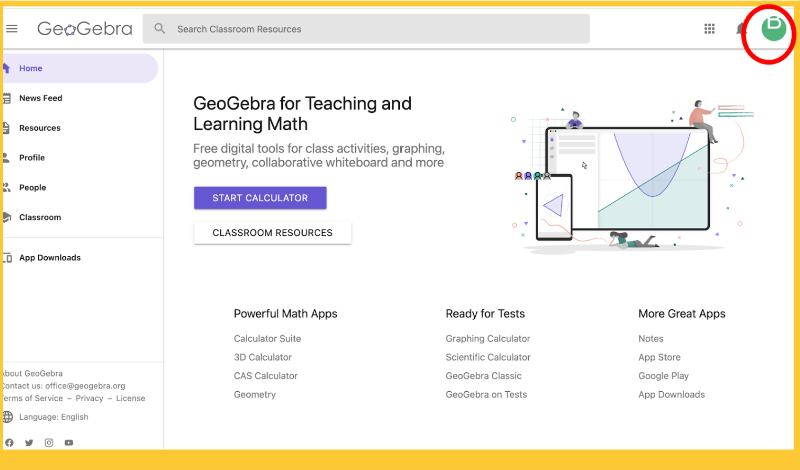
In the next step, teachers should select the button ‘Create’ and then ‘Book’, figure 2.
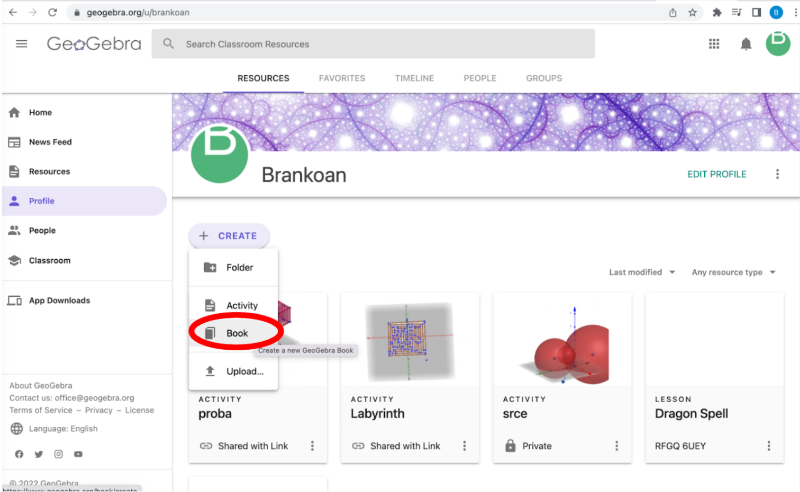
After that, teachers will get a book working space in which they need to define: Book title, Language, Provide a short book description, target group age, and tags. On this point, teachers should also decide how they would like to share their books. There are several possibilities for sharing: private- the book is visible only to the teacher which is preparing the book; share with a link- only users who have the link can view this book; public - other users can find and view the book, figure 3.
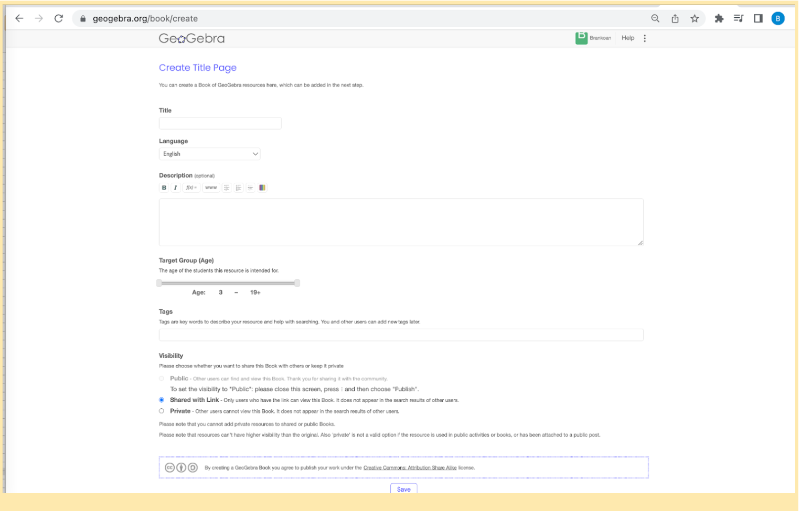
The next step is that teachers can develop several chapters in their book and title them, figure 4.
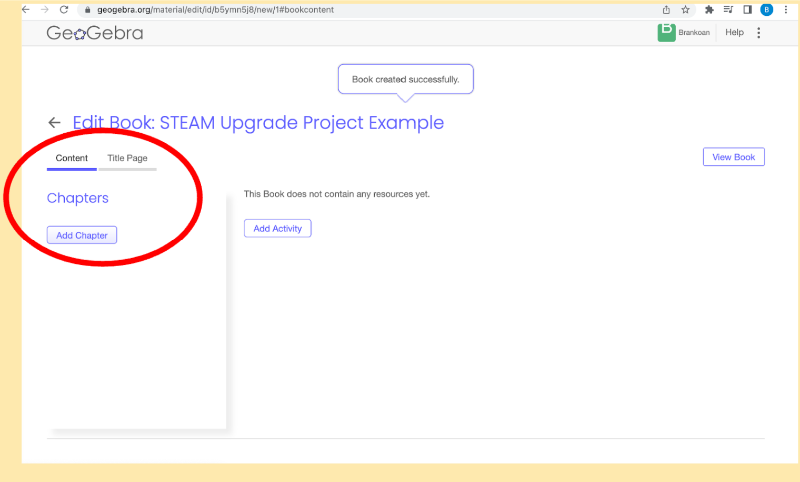
In their book, chapter teachers can include their worksheets or worksheets of others. When teachers want to add existing activities, they can type the name in the search space (figure 5), and when they want to add a new activity they should select the new activity button, figure 5. If teachers choose new activities as an adding option, then they can add other digital materials such as video, pdf, weblinks, and similar.
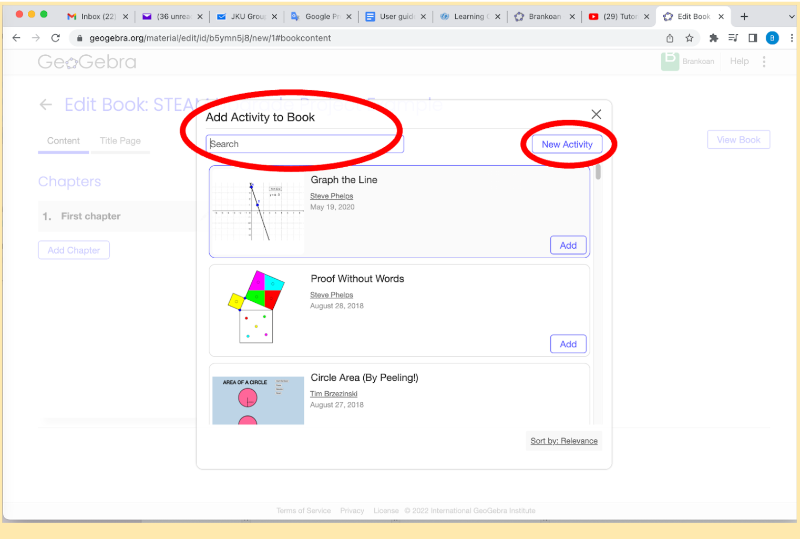
The same principle teachers can use to add additional chapters and activities in their books.
The activity solution
The creation and publishing of interactive GeoGebra books will help teachers to share digital learning and teaching materials with students. Teachers also in this type of book can promote students' work, add homework for students, create quiz questions, and similar.
Enhancing the Activity
In an aim to enhance students’ digital skills teachers can assign them to do homework in a digital learning-teaching environment and promote the best students' work in GeoGebra interactive books. This promotion can contribute to the student’s motivation to participle in learning activities.
The knowledge test
What are the basic principles of universal design that textbooks and digital teaching tools are based on in European schools?
What is GeoGebra is not possible to integrate into the GeoGebra book?
What are not some of the obstacles that teachers face when sharing different types of developed materials such as texts, video, audio, or animated educational materials?
For special needs’ learners
Students with learning difficulties and/or low cognitive abilities should get to know GeoGebra individually before performing activities with a group - this will help them better understand the task and be successful in joint activities.
Alternative activity
Realization of this educational activity requires the use of tablets or mobile phones on which it is possible to install the GeoGebra application, and the internet. If the school does not have the possibility to apply this technology, teachers can prepare their digital materials in the form of pdf and share it later when conditions improve in the form of an interactive GeoGebra book.
Conducting a Workshop
This workshop supports pre-service and in-service teachers to develop their digital skills and, in doing so, teachers can share their digital learning materials with, students, colleagues, and associations of teachers or students, or similar target groups.
References
Cvjetićanin, S., Lavicza, Z., Maričić, M., Novović, T., & Stešević, D. (2021). Mobile and printed dichotomous keys in constructivist learning of biology in primary school. Research in Science & Technological Education, 39(4), 393-420. https://doi.org/10.1080/02635143.2020.1763290
Lavicza, Z., Weinhandl, R., Prodromou, T., Anđić, B., Lieban, D., Hohenwarter, M., ... & Diego-Mantecón, J. M. (2022). Developing and Evaluating Educational Innovations for STEAM Education in Rapidly Changing Digital Technology Environments. Sustainability, 14(12), 7237. https://doi.org/10.3390/su14127237
Alvino, S., Bocconi, S., Boytchev, P., Earp, J., & Sarti, L. (2009). Sharing digital resources in teacher education: an ontology-based approach. http://hdl.handle.net/10506/249